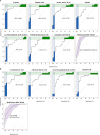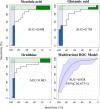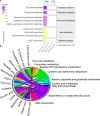The effects of gestational diabetes mellitus with maternal age between 35 and 40 years on the metabolite profiles of plasma and urine
- PMID: 35236326
- PMCID: PMC8892719
- DOI: 10.1186/s12884-022-04416-5
The effects of gestational diabetes mellitus with maternal age between 35 and 40 years on the metabolite profiles of plasma and urine
Abstract
Background: Gestational diabetes mellitus (GDM) is defined as impaired glucose tolerance in pregnancy and without a history of diabetes mellitus. While there are limited metabolomic studies involving advanced maternal age in China, we aim to investigate the metabolomic profiling of plasma and urine in pregnancies complicated with GDM aged at 35-40 years at early and late gestation.
Methods: Twenty normal and 20 GDM pregnant participants (≥ 35 years old) were enlisted from the Complex Lipids in Mothers and Babies (CLIMB) study. Maternal plasma and urine collected at the first and third trimester were detected using gas chromatography-mass spectrometry (GC-MS).
Results: One hundred sixty-five metabolites and 192 metabolites were found in plasma and urine respectively. Urine metabolomic profiles were incapable to distinguish GDM from controls, in comparison, there were 14 and 39 significantly different plasma metabolites between the two groups in first and third trimester respectively. Especially, by integrating seven metabolites including cysteine, malonic acid, alanine, 11,14-eicosadienoic acid, stearic acid, arachidic acid, and 2-methyloctadecanoic acid using multivariant receiver operating characteristic models, we were capable of discriminating GDM from normal pregnancies with an area under curve of 0.928 at first trimester.
Conclusion: This study explores metabolomic profiles between GDM and normal pregnancies at the age of 35-40 years longitudinally. Several compounds have the potential to be biomarkers to predict GDM with advanced maternal age. Moreover, the discordant metabolome profiles between the two groups could be useful to understand the etiology of GDM with advanced maternal age.
Keywords: Advanced maternal age; Gestational diabetes mellitus; Metabolomics; Pregnancy.
© 2022. The Author(s).
Conflict of interest statement
The authors confirm there are no competing interests.
Figures




References
-
- Wang C, Wang XY, Yang HX. Effect of maternal age on pregnancy outcomes in Beijing. Zhonghua Fu Chan Ke Za Zhi. 2017;52(8):514–520. - PubMed
MeSH terms
LinkOut - more resources
Full Text Sources
Miscellaneous

